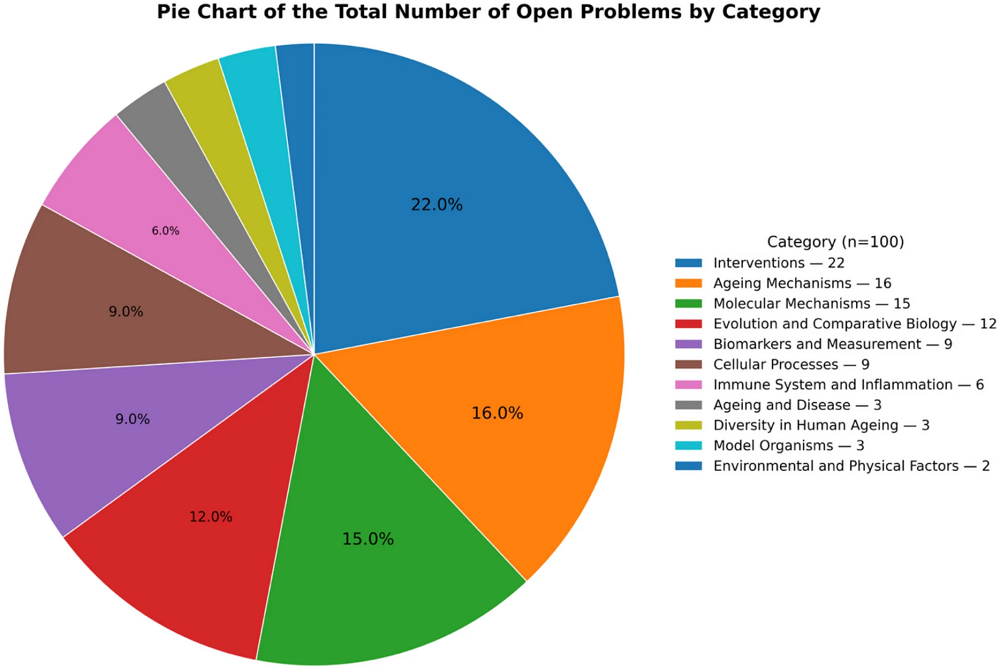In GeroScience, a large team of researchers, including João Pedro de Magalhães, has described a hundred currently unsolved problems in the field.
Finding the right questions
Understanding the fundamental nature of aging has been a problem since people first endeavored to live longer, to the point that finding the right questions can matter more than finding the right answers. Nearly fifty years ago, B.L. Strehler attempted to tackle this in Time, Cells, and Aging [1], and there has been skepticism as to whether it can be done at all [2]. As the field has completely changed between now and Strehler’s time, these researchers chose to revisit the topic, using modern analysis techniques the most frequently asked questions in research.
These questions came from a few sources. First, they sought comments from the research community, collecting a total of 160 open problems and adding them to their database. Additionally, they held a 3-day workshop with 24 scientists in order to gain a better view of the field, creating groups and brainstorming unsolved problems, gaining another 130.
Then, the researchers filtered these problems for similarity and relevance, reducing the number to 204. They quested for how frequently these problems were mentioned in article abstracts, using a natural language processing algorithm and multiple checks to ensure that the articles and problems matched. Of these 204 problems, 100 were selected by Prof. de Magalhães for inclusion into the OpenLongevity database.
The biggest question is why
Unsurpisingly, the biggest overall question is “Why do we age?”, with 10,808 scientific articles asking this question. This was followed by a question about somatic mutation accumulation, which had 5,977. Questions about cellular processes and species longevity followed, as were questions involving fundamental aging processes in animals and whether or not those processes translate to humans. Biomarkers were also major aspects of concern. A broad question about interventions involving cellular function was less commonly asked than questions about these fundamental questions of aging.
Intervention-related questions, however, were the most commonly found on the list. These questions involved targeting inflammation, utilizing embryogenetic processes to slow aging, and employing partial reprogramming techniques. Many other questions involved the amount of overall damage that originates from particular aspects of aging, such as the secretions of senescent cells.

There were also questions that were almost never asked, mostly involving very little-researched, very particular aspects of the field. For example, only one paper asked about the homeodynamic space, which refers to organizational stability. Only a few papers asked about prioritizing interventions, and mitochondrial citrate and immune responses to mutated cells were also lightly explored topics.
The field has come a long way, but there is still much to do
There are similarities between the questions of today and the questions asked by Strehler in 1977, although he focused more on central nervous system disorders and some questions regarding inter-species differences have been fairly well resolved. Modern research is still exploring the roles of mitochondria, although the modern focus is more on such cellular dynamics than on the fundamental aspects of biology, such as enzymes and ribosomes, that were of scientific interest at the time and are largely well-understood today. However, how these biological components are changed during aging is not always certain.
Answering questions in science, especially the sorts of complex questions involved in biology, often leads to more questions. These 100 questions are intended to be fundamental to the field, and while answering them may lead to more questions, the process may lead to interventions that extend healthy human lifespan.
Literature
[1] Strehler, B. (1977). Some unexplored avenues of cellular aging—current and future research. Time, Cells and Aging, edited by Strehler, B, 374-418.
[2] Partridge, L. (2010). The new biology of ageing. Philosophical Transactions of the Royal Society B: Biological Sciences, 365(1537), 147-154.
View the article at lifespan.io










































